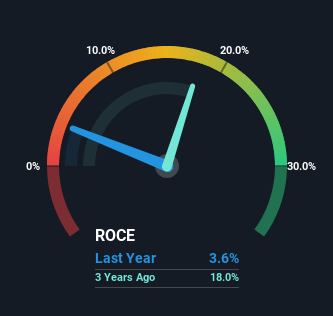Investors Could Be Concerned With Lazydays Holdings' (NASDAQ:GORV) Returns On Capital
If you're looking for a multi-bagger, there's a few things to keep an eye out for. Typically, we'll want to notice a trend of growing return on capital employed (ROCE) and alongside that, an expanding base of capital employed. Ultimately, this demonstrates that it's a business that is reinvesting profits at increasing rates of return. In light of that, when we looked at Lazydays Holdings (NASDAQ:GORV) and its ROCE trend, we weren't exactly thrilled.
What Is Return On Capital Employed (ROCE)?
Just to clarify if you're unsure, ROCE is a metric for evaluating how much pre-tax income (in percentage terms) a company earns on the capital invested in its business. To calculate this metric for Lazydays Holdings, this is the formula:
Return on Capital Employed = Earnings Before Interest and Tax (EBIT) ÷ (Total Assets - Current Liabilities)
0.036 = US$16m ÷ (US$938m - US$500m) (Based on the trailing twelve months to December 2023).
So, Lazydays Holdings has an ROCE of 3.6%. In absolute terms, that's a low return and it also under-performs the Specialty Retail industry average of 14%.
See our latest analysis for Lazydays Holdings
In the above chart we have measured Lazydays Holdings' prior ROCE against its prior performance, but the future is arguably more important. If you'd like to see what analysts are forecasting going forward, you should check out our free analyst report for Lazydays Holdings .
What Can We Tell From Lazydays Holdings' ROCE Trend?
Unfortunately, the trend isn't great with ROCE falling from 7.3% five years ago, while capital employed has grown 91%. That being said, Lazydays Holdings raised some capital prior to their latest results being released, so that could partly explain the increase in capital employed. It's unlikely that all of the funds raised have been put to work yet, so as a consequence Lazydays Holdings might not have received a full period of earnings contribution from it.
While on the subject, we noticed that the ratio of current liabilities to total assets has risen to 53%, which has impacted the ROCE. Without this increase, it's likely that ROCE would be even lower than 3.6%. What this means is that in reality, a rather large portion of the business is being funded by the likes of the company's suppliers or short-term creditors, which can bring some risks of its own.
The Bottom Line
From the above analysis, we find it rather worrisome that returns on capital and sales for Lazydays Holdings have fallen, meanwhile the business is employing more capital than it was five years ago. Long term shareholders who've owned the stock over the last five years have experienced a 25% depreciation in their investment, so it appears the market might not like these trends either. With underlying trends that aren't great in these areas, we'd consider looking elsewhere.
One more thing: We've identified 4 warning signs with Lazydays Holdings (at least 1 which is potentially serious) , and understanding these would certainly be useful.
While Lazydays Holdings isn't earning the highest return, check out this free list of companies that are earning high returns on equity with solid balance sheets.
Have feedback on this article? Concerned about the content? Get in touch with us directly. Alternatively, email editorial-team (at) simplywallst.com.
This article by Simply Wall St is general in nature. We provide commentary based on historical data and analyst forecasts only using an unbiased methodology and our articles are not intended to be financial advice. It does not constitute a recommendation to buy or sell any stock, and does not take account of your objectives, or your financial situation. We aim to bring you long-term focused analysis driven by fundamental data. Note that our analysis may not factor in the latest price-sensitive company announcements or qualitative material. Simply Wall St has no position in any stocks mentioned.

